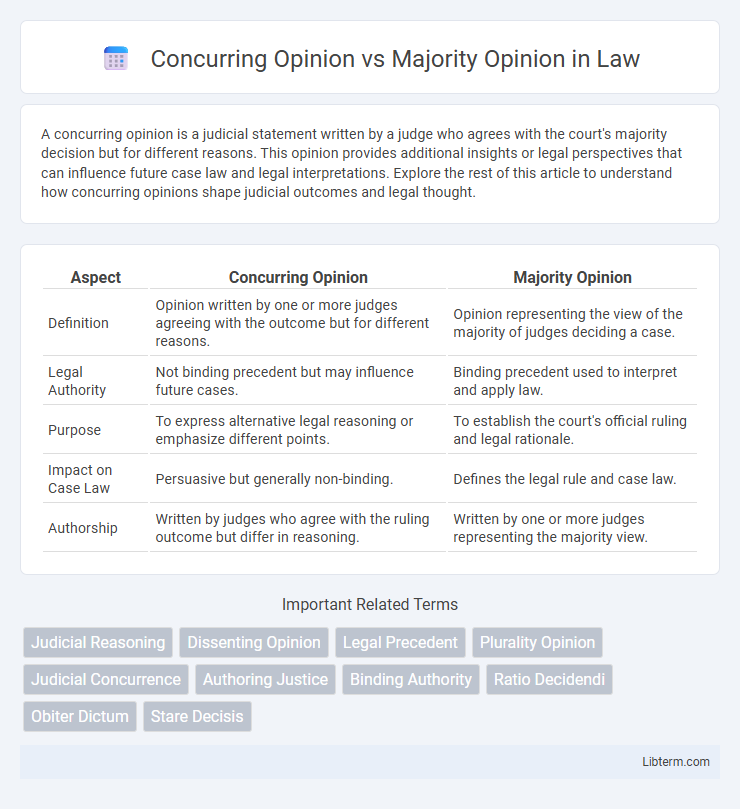A concurring opinion is a judicial statement written by a judge who agrees with the court's majority decision but for different reasons. This opinion provides additional insights or legal perspectives that can influence future case law and legal interpretations. Explore the rest of this article to understand how concurring opinions shape judicial outcomes and legal thought.
Table of Comparison
| Aspect | Concurring Opinion | Majority Opinion |
|---|---|---|
| Definition | Opinion written by one or more judges agreeing with the outcome but for different reasons. | Opinion representing the view of the majority of judges deciding a case. |
| Legal Authority | Not binding precedent but may influence future cases. | Binding precedent used to interpret and apply law. |
| Purpose | To express alternative legal reasoning or emphasize different points. | To establish the court's official ruling and legal rationale. |
| Impact on Case Law | Persuasive but generally non-binding. | Defines the legal rule and case law. |
| Authorship | Written by judges who agree with the ruling outcome but differ in reasoning. | Written by one or more judges representing the majority view. |
Definition of Concurring Opinion
A concurring opinion is a judicial statement written by one or more judges who agree with the majority's decision but for different legal reasons. This opinion provides an alternative rationale or perspective that supports the case outcome without altering the majority judgment. Unlike the majority opinion, a concurring opinion does not establish binding precedent but can influence future legal interpretations.
Definition of Majority Opinion
The majority opinion is the official judicial ruling agreed upon by more than half of the judges in a court case, serving as the binding precedent for lower courts and future cases. It explains the legal reasoning and principles that justify the court's decision and resolves the key issues presented during the trial. Unlike concurring opinions, which agree with the outcome but offer different reasoning, the majority opinion establishes the authoritative interpretation of the law.
Purpose of Concurring Opinions
Concurring opinions serve to express a judge's agreement with the majority's final decision while emphasizing different legal reasoning or highlighting particular issues. They provide alternative perspectives that contribute to the development of case law without altering the outcome. This allows the judiciary to address nuances and clarify points of law that may influence future rulings.
Purpose of Majority Opinions
Majority opinions establish the binding legal precedent by articulating the court's official ruling and legal reasoning, guiding lower courts and future cases. Their primary purpose is to provide clear, authoritative interpretations of law that promote consistency and predictability in the judicial system. Unlike concurring opinions, which offer alternative reasoning or emphasize different aspects, majority opinions serve as the definitive judgment of the court.
Key Differences Between Concurring and Majority Opinions
Concurring opinions agree with the majority's final decision but provide different or additional reasoning, emphasizing unique legal principles or interpretations. Majority opinions represent the official ruling of the court, establishing binding precedent with the judicial rationale adopted by most judges. The key difference lies in authority: majority opinions set binding law, while concurring opinions offer supplementary perspectives without creating precedent.
Legal Impact of Concurring vs Majority Opinions
Concurring opinions agree with the majority's outcome but offer different legal reasoning, which can influence future case law by providing alternative interpretations of the law. Majority opinions establish binding precedent as the authoritative ruling of the court, shaping judicial standards and legal frameworks. While concurring opinions lack binding authority, their legal interpretations can guide lower courts and inform evolving jurisprudence.
Role in Shaping Case Law
The majority opinion establishes the binding precedent and provides the authoritative interpretation of the law in a particular case, shaping future judicial decisions and legal standards. Concurring opinions, while agreeing with the majority's outcome, offer alternative legal reasoning or highlight different aspects of the case, influencing the development of case law through persuasive authority. Both play crucial roles in the evolution of legal principles, with majority opinions setting the primary framework and concurring opinions contributing to nuanced judicial discourse.
Examples in Landmark Supreme Court Cases
In the landmark Supreme Court case *Brown v. Board of Education* (1954), the majority opinion declared racial segregation in public schools unconstitutional, while concurring opinions emphasized different legal reasoning and social implications. In *Obergefell v. Hodges* (2015), the majority opinion legalized same-sex marriage nationwide, with several concurring opinions underscoring varied constitutional interpretations and policy considerations. These examples illustrate how concurring opinions provide additional perspectives that complement or expand upon the binding legal rationale established by the majority opinion.
Advantages and Disadvantages of Each Opinion Type
Concurring opinions offer the advantage of providing alternative legal reasoning that can influence future cases, though they may create ambiguity in the court's final ruling and complicate precedent. Majority opinions establish clear, authoritative legal principles that guide lower courts and ensure consistency, but they might oversimplify complex issues by glossing over dissenting perspectives. Both opinion types play crucial roles in shaping jurisprudence, balancing clarity with the richness of judicial analysis.
Influence on Future Judicial Decisions
Concurring opinions, while agreeing with the majority's outcome, provide alternative legal reasoning that can influence future judicial interpretations and legislative developments by offering nuanced perspectives. Majority opinions establish binding precedent that courts are generally required to follow, thereby shaping the legal landscape and guiding future case law. The interplay between majority rulings and concurring opinions enriches judicial discourse, potentially leading to shifts in legal standards over time.
Concurring Opinion Infographic

 libterm.com
libterm.com